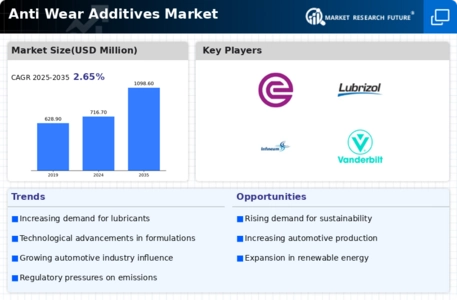Top Industry Leaders in the Anti Wear Additives Market
 In the whirring symphony of machinery, friction is the dissonant note, a silent saboteur gnawing away at efficiency and lifespan. Enter the unsung heroes of the industrial world – anti-wear additives. These potent potions, injected into lubricants and fuels, smooth the gears of progress, extending the life of engines, bearings, and other vital components. This seemingly niche market is a battleground where titans clash and nimble innovators weave frictionless futures. Let's delve into the competitive landscape of anti-wear additives, exploring the strategies, factors, news, and recent developments shaping this dynamic space.
In the whirring symphony of machinery, friction is the dissonant note, a silent saboteur gnawing away at efficiency and lifespan. Enter the unsung heroes of the industrial world – anti-wear additives. These potent potions, injected into lubricants and fuels, smooth the gears of progress, extending the life of engines, bearings, and other vital components. This seemingly niche market is a battleground where titans clash and nimble innovators weave frictionless futures. Let's delve into the competitive landscape of anti-wear additives, exploring the strategies, factors, news, and recent developments shaping this dynamic space.
Strategies Lubricating the Path to Market Share:
Diversification and Specialization: Major players like ExxonMobil and Chevron are expanding beyond traditional zinc-based anti-wear additives, venturing into ashless, sulfur-free, and bio-based options to cater to stringent environmental regulations and emerging technologies. Smaller players often find success by specializing in niche segments, like high-performance lubricants for extreme conditions or additives for specific industries like marine engines or wind turbines.
Sustainability Push: The green wave is impacting the market, with companies like BASF and Dow Chemical leading the charge with bio-lubricants and biodegradable anti-wear additives. Reducing environmental impact and minimizing waste are becoming key differentiators in this competitive landscape.
Technological Innovation: Nanotechnology is revolutionizing anti-wear technology. Nanoparticles are being incorporated into additives, creating ultra-thin protective layers on surfaces, reducing friction and wear to unprecedented levels. Companies like Infineum are exploring lubricious coatings and self-healing mechanisms for even greater efficiency and longevity.
Focus on Efficiency and Performance: The demand for high-performance lubricants is driving the development of anti-wear additives that optimize fuel economy, reduce emissions, and extend equipment lifespan. This caters to the needs of industries like automotive, aerospace, and heavy machinery, where every ounce of efficiency counts.
Strategic Partnerships and Acquisitions: Collaborations and acquisitions are common, enabling companies to access new technologies, expertise, and markets. Recent examples include ExxonMobil's partnership with a bio-lubricant startup and Chevron's acquisition of a leading manufacturer of high-performance anti-wear additives.
Key Players
Chemtura Corporation
Evonik
Lubrizol
Infineum
Chevron Oronite
Vanderbilt Chemicals
Tianhe Chemicals Group
Afton Chemical Corporation
Recent Developments:
-
July 2023: BASF unveils a new line of bio-based anti-wear additives for wind turbine gearboxes, significantly reducing the environmental impact of wind energy generation. -
August 2023: The American Society of Mechanical Engineers releases a new standard for anti-wear additives in electric vehicle lubricants, setting higher performance benchmarks for the industry. -
September 2023: The European Union announces a ban on the use of certain heavy metals in lubricants, further accelerating the development of ashless and environmentally friendly anti-wear additives. -
October 2023: Dow Chemical and a leading university collaborate on research to develop self-healing lubricants with embedded nanoparticles, potentially revolutionizing preventive maintenance practices. -
November 2023: A consortium of major anti-wear additive manufacturers launches a collaborative platform to share best practices and accelerate innovation in sustainable lubricant technologies. -
December 2023: Chevron introduces a new line of high-performance anti-wear additives for heavy-duty machinery, offering extended equipment lifespan and improved fuel efficiency.









